Greenock and Port Glasgow Tramways
History
Powers to construct a horse-tramway system within Greenock were granted to the local authority (the Board of Police of Greenock) on the 29th June 1871, under the Greenock Street Tramways Act, 1871.
At virtually the same time, a group of independent promoters were attempting to secure powers to construct around 20 miles of tramway between Port Glasgow, Greenock, Gourock and Ashton, as well as between Glasgow, Govan, Paisley and Johnstone. The promoters agreed to remove the section in Greenock from their parliamentary bill, presumably in exchange for an undertaking from the Board of Police that it would lease its lines to them. This made perfect sense, as local authorities needed to lease the tramways they built and owned, all local authorities being prevented from operating them by legislation (the Tramways Act of 1870).
The promoters obtained powers for their own tramways on the 13th July 1871, under the Vale of Clyde Tramways Act, 1871, just two weeks after the Board of Police had acquired its powers; the act also incorporated a company — the Vale of Clyde Tramways Company (VofCTCo) — to build and operate the lines.
Of the VofCTCo's other tramway lines, which were geographically unconnected to those in Port Glasgow, Greenock, Gourock and Ashton, only those in Govan were ever built; these are dealt with separately (see link).
The first section of tramway to open was in Greenock — on the 7th July 1873 — from Rue End Street in the east of the burgh to Gourock Toll in the west. Eleven days later (on the 18th July 1873) the services were extended westwards (over VofCTCo-owned lines) to Gourock Pier, and finally, on the 1st November 1873, to the western terminus in Albert Street, Ashton.
The horse-tram services were operated by the VofCTCo with twelve horsecars, the section in Greenock being under a 21-year lease arrangement, which was signed in June 1872, but only confirmed on the 29th June 1875, under the Greenock Police and Improvement Act, 1875. The lease was set to expire at the end of the day on the 14th May 1893.
The VofCTCo obtained powers to use mechanical traction on its tramways on the 27th June 1876 under the Vale of Clyde Tramways Act, 1876. Although the company successfully implemented steam traction on its Govan lines, it only ever operated steam tram engines on a trial basis in Gourock, being refused a provisional order by the Board of Trade, for reasons which are unclear.
Whilst the VofCTCo held powers for a continuation of the system eastwards from Greenock to Port Glasgow, it failed to construct the line within the stipulated timeframe (three years) or to extend the time allowed for construction. Eventually, new promoters stepped in, obtaining new powers on the 8th August 1887, under the Greenock and Port Glasgow Tramways Act, 1887, which also authorised the formation of a new company to build and operate the line, the Greenock and Port Glasgow Tramways Company (G&PGTCo). The new line was opened on the 29th November 1889 using eleven horsecars, but was operated as a separate service, the G&PGTCo cars stopping at the Greenock boundary, with through passengers having to change cars.
Given that the VofCTCo had failed to build the majority of its lines, it was significantly over-capitalised, a situation that it endeavoured to remedy with the passing of the Vale of Clyde Tramways Act, 1888 (on the 7th August). This act authorised the reconstruction of the company, and with one eye on the future, the use of mechanical traction (including electric), as well as powers to sell or lease its lines to the various local authorities in whose areas it operated.
The necessity of changing operators at Greenock's eastern boundary was removed on the 15th May 1893, following the expiry of the VofCTCo's Greenock lease, the VofCTCo having been outbid by the G&PGTCo, the latter now operating right through from Port Glasgow to Greenock's western boundary with Inverkip, where the VofCTCo's tracks began. Although this merely shifted the inconvenience from one side of the burgh to the other, it was destined to be short lived.
The VofCTCo had known for some time that both its tramways — in Govan and in Gourock — were under threat of municipalisation, the local authorities having the right — under the Tramways Act, 1870 — to compulsorily purchase the lines within their respective areas 21 years after the passing of the enabling act, i.e., from July 1892. It is perhaps therefore unsurprising that the VofCTCo quickly reached agreement with both the principal local authorities (Govan and Gourock Commissioners of Police), selling its Govan lines on the 9th July 1893 and its Gourock lines on the 1st February 1894, the latter having incurred losses in the 1890s.
Following the sale of the Gourock tramway to the Commissioners of Police of Gourock, operation of the line was leased to the G&PGTCo. The latter took over from the VofCTCo on the 12th February 1894, operating the full line with seventeen horse trams, some acquired from the VofCTCo, with three new ones being added in 1900.
The horse tramway, which was built to a gauge of 4ft 7¾ins, was around 7.4 miles long. From a terminus in Bay Street, Port Glasgow, the tramway ran westwards, parallel to the Firth of Clyde, through Ladyburn, Greenock and Gourock to a terminus in Albert Road, Ashton, close to what is currently Gourock Royal Yacht Club. There was also a very short branch to Princes Pier in Greenock.
During the late 1890s, the British Electric Traction Company (BETCo) appeared on the scene, a company which was embarking on a journey that would see it become a major player in the tramway world. It began by purchasing horse and steam-operated tramways across the British Isles with the intention of converting them to electric traction, as well as promoting schemes for completely new electric tramways, and was destined to own, part-own or lease around 50 tramway concerns across the United Kingdom. The BETCo reached a provisional agreement to acquire the G&PGTCo on the 8th June 1898, thereafter opening negotiations with the three local authorities (Port Glasgow, Greenock and Gourock) to gain their support for electrification of the tramway. Powers to convert the entire tramway to overhead electric traction were granted on the 1st August 1899, under the Greenock and Port Glasgow Tramways Act, 1899.
Work now proceeded apace, virtually the entire tramway being doubled during 1900, ahead of the introduction of electric services. Leases were signed with the three local authorities during 1900, that with Greenock expiring in 1914 (renewable at 7-year intervals thereafter), that with Gourock in 1929 and that with Port Glasgow in 1936.
Conversion to overhead electric traction commenced on the 6th December 1900, the system being opened in two halves during late 1901: Ashton to Rue End Street on the 3rd October, and Rue End Street to Port Glasgow five weeks later on the 7th November, the day the last horse tram ran. The initial services were operated with 22 tramcars, rising to 30 by the end of 1902.
Powers to build a short extension along Bay Street in Port Glasgow were granted on the 8th August 1902, under the Greenock and Port Glasgow Tramways (Extension) Order Confirmation Act, 1902. The extension was opened on the 26th October 1903, and took the system to its final size of 7.42 miles. From the new terminus in Port Glasgow (at the junction of Bay Street and Robert Street), the tramway effectively followed the course of the old horse tramway, through Greenock and Gourock to a terminus in Albert Road, Ashton, close to the Gourock Royal Yacht Club.
The tramway appears to have been well-used, rising to a peak of over 16 million passengers per year by 1918. This allowed the company (the G&PGTCo) to pay an average dividend of 3.9% up to 1914, rising to an average of 8% during the Great War. By 1916, the fleet had risen to 48 vehicles, to cope with the greatly increased patronage.
Like most tramways across the British Isles, the G&PGT suffered from the exigencies of the Great War, including loss of men (and their skills) to the armed forces, severe restrictions on the procurement of tramcars, spares and track, and very heavy usage due to the unprecedented expansion in armaments manufacture. By the end of the conflict, the tramway was in poor condition, with much of its infrastructure aging, and with a significant maintenance backlog. In 1919, the company was nevertheless still confident enough in the future of the tramway to raise proposals for extensions, and to begin putting the tramway in order.
Although the company ostensibly had a 28-year lease agreement with Greenock Corporation, it would appear that this was renegotiable at certain time points. The first of these dates (15th May 1914) passed without incident, but by the second (15th May 1921) there was significant discussion within and between the local authorities about municipalisation, though in the end no action was taken.
By the early 1920s, the company was exposed to significant unregulated bus competition, passenger numbers falling by a staggering 50% between 1918 and 1922. The situation was further compounded by post-war inflation and a severe downturn in trade in the district, the outlook for the company looking grim indeed. In September 1925, the company resorted to introducing its own motorbus services to combat the competition, even though this move was bound to extract yet more passengers from the trams.
By November 1926, the company had clearly had enough, and informed Greenock Corporation that it would not be renewing its lease after the next expiry date, which was the 15th May 1928. The company claimed to be losing £300 per week, and proposed that the lease be terminated, that various sections of the tramway be closed, and that buses be substituted in their place, threatening to go into liquidation should the corporation fail to play ball.
Greenock Corporation, which was neither interested in agreeing to the company's proposals nor municipalising the tramway — though it did in fairness consider the latter — left the company little choice but to seek parliamentary powers to abandon the tramway and substitute motorbuses services. Despite formal opposition from the local authorities, which derived income from the tramway in the shape of rental and wayleave payments, powers for the abandonment were granted on the 3rd August 1928 under the Greenock and Port Glasgow Tramways Act, 1928. The act also changed the name of the company from the Greenock and Port Glasgow Tramways Company to the Greenock Motor Services Company.
By May 1929, the new company's motorbuses had almost completely taken over the tram services, the last tram of all running on the 15th July 1929.
Uniforms
Photographs have survived that depict staff working the horse-drawn services operated by both the Vale of Clyde Tramways Company (1873-1893) and the Greenock and Port Glasgow Tramways Company (1889-1901); these clearly show that both conductors and drivers wore informal but robust attire: greatcoats, coachmen's coats, jackets and hats, the latter more often than not, the bowler. No badges or licences of any description appear to have been worn.
Photographs taken after electrification show G&PGTCo staff wearing the familiar and largely regulation BETCo uniform; although jackets appeared to vary somewhat between BETCo systems, as well as across the decades, the cap badges, collar designations and buttons invariably followed a standard pattern. The uniform jackets were single-breasted with five buttons (presumably brass and of the standard BETCo pattern — see link), a single breast pocket (on the bearer's left-hand side), and stand-up collars; the latter the company's initials, which somewhat unusually spanned both collars, 'G & P' on the bearer's right-hand side and 'G T Co' on the left-hand side (in individual brass letters). The tensioned-crown peaked caps carried the standard BETCo ‘Magnet & Wheel’ cap badge (see below) with an employee number worn below (all brass). This style of jacket appears to have been worn until the late-Edwardian era, when it was superseded — at least for motormen — by double-breasted lancer-style tunics with five pairs of buttons (narrowing from top to bottom) and stand-up collars; the latter now arried system initials rather than company initials on the bearer's right-hand collar ('G & P G T') and an employee number on the left.
Tramcar crews were also issued with long, double-breasted greatcoats with five pairs of buttons, two waist-level pockets (with flap closures), epaulettes and high fold-over collars; whilst the latter were left plain, the epaulettes bore employee numbers.
Inspectors wore single-breasted jackets with hidden buttons (or more likely a hook and eye affair), and stand-up collars; the jackets were edged in a finer material than the main body of the jacket, with the collars bearing the grade — 'Inspector' — in embroidered script lettering. The tensioned-crown peaked caps also bore the grade in embroidered script lettering — 'Inspector' — but on a hat band, above which the standard BETCo cap badge was mounted. Inspectors were also issued with long, double-breasted greatcoats with high fold-over collars, but without epaulettes; the collars bore the grade — 'Inspector' — in embroidered script lettering.
In common with the vast majority of UK tramway systems, female staff were employed during the Great War to replace men lost to the armed services; these ladies were initially employed as conductresses, but later on as motorwomen too, and from December 1917, inspectresses. Like many Scottish systems, the ladies were kept on well after the conclusion of the conflict. Female tramcar staff were issued with tailored, single-breasted jackets with five buttons, lapels, two hip pockets, a breast pocket (with button closures) and a waist belt (with two button fastenings), along with a medium-length matching skirt; the jackets were devoid of badges. Headgear initially took the form of a felt bonnet with brim, though by the end of the war, these has been superseded by baggy peaked caps with glossy peaks (often called motor caps); these usually bore the standard BETCo cap badge, though this was frequently replaced by a regimental or sweetheart badge.
Further reading
For a history of the tramway, see: 'Tramways of Greenock, Gourock and Port Glasgow' by Ian L McCormack; the Scottish Tramway Museum Society (1975).
Images
Horse tram drivers and conductors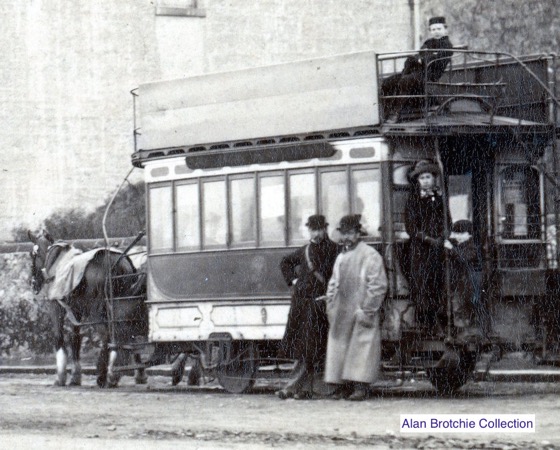
Vale of Clyde Tramways Company Horsecar No 9 and crew at the Ashton terminus — photo undated, but very probably taken in the 1870s.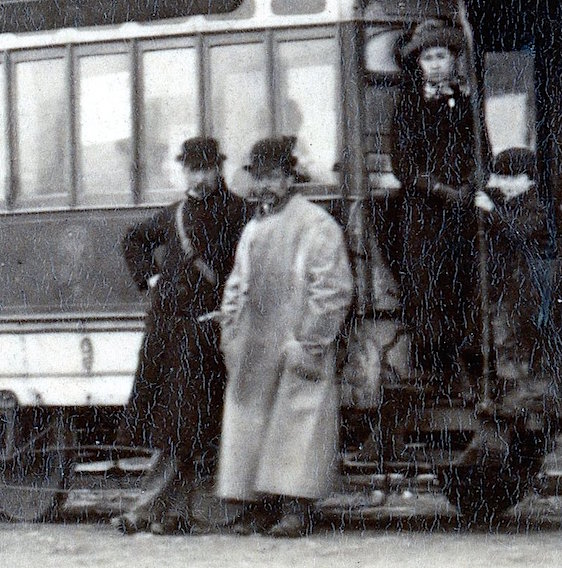
An enlargement of the above photograph showing the conductor (left) and the driver (right), both of whom are wearing informal attire, the latter in typical coachman's gear.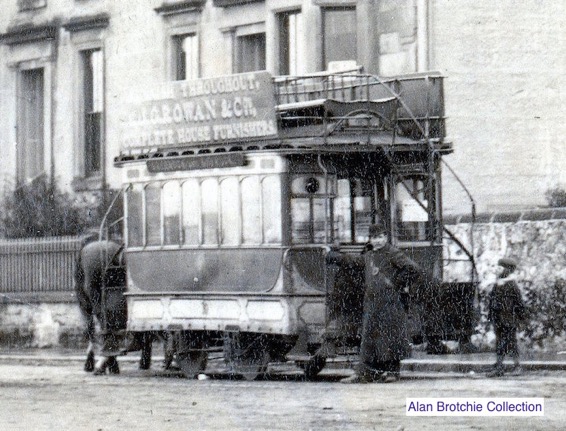
Another photograph of the Ashton terminus, this time of Horsecar No 10, taken on the same day as the shot above (it is taken from the same negative).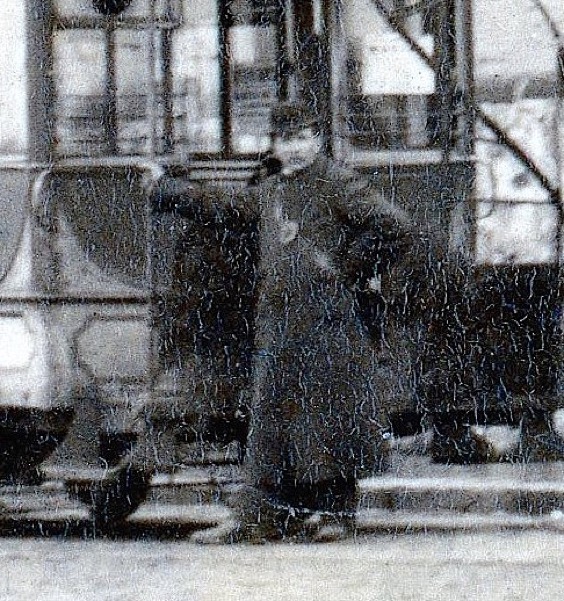
An enlargement of the above photograph showing the conductor, who is wearing fairly robust attire, presumably designed to protect him against the vagaries of the local weather.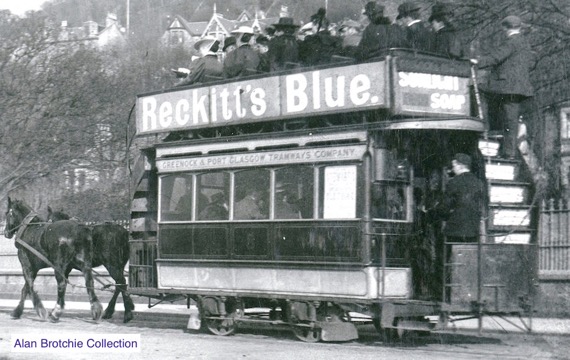
Greenock and Port Glasgow Tramways Company Horsecar No 8 heading away from the Ashton terminus — photo undated, but certainly taken no earlier than February 1894.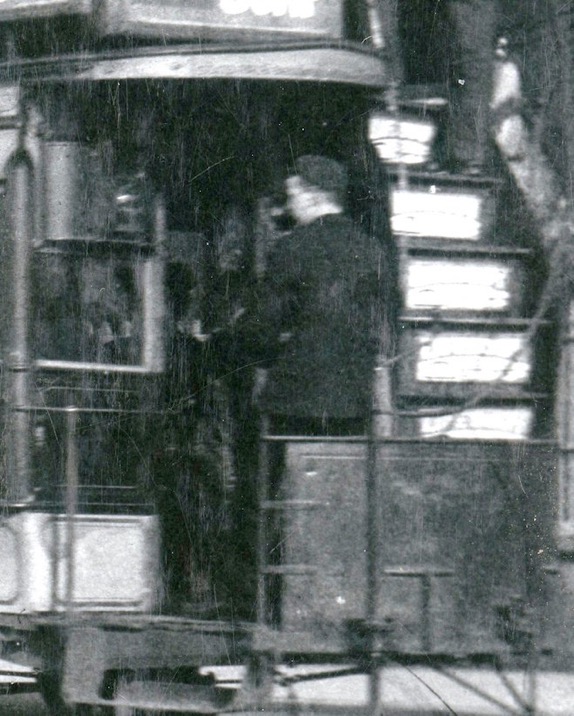
An enlargement of the above photograph showing the conductor (his cash-bag strap can just be discerned) — he appears to be wearing informal attire, along with a flat cap.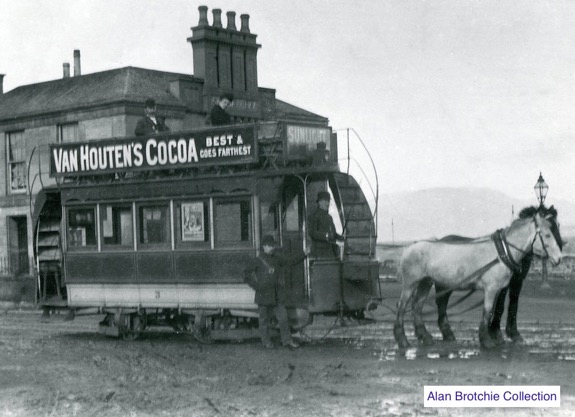
G&PGTCo Horsecar No 3 taken at Cardwell Bay — photo dated 1898.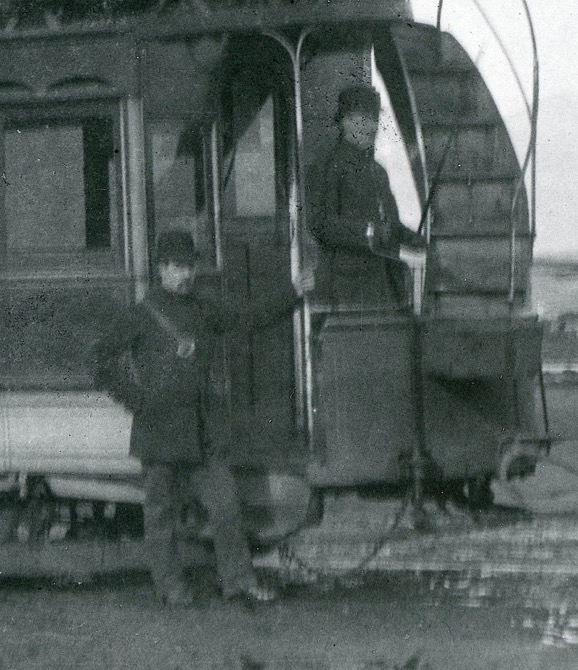
An enlargement of the above photograph showing the conductor and the driver, both of whom are wearing informal attire.
Motormen and conductors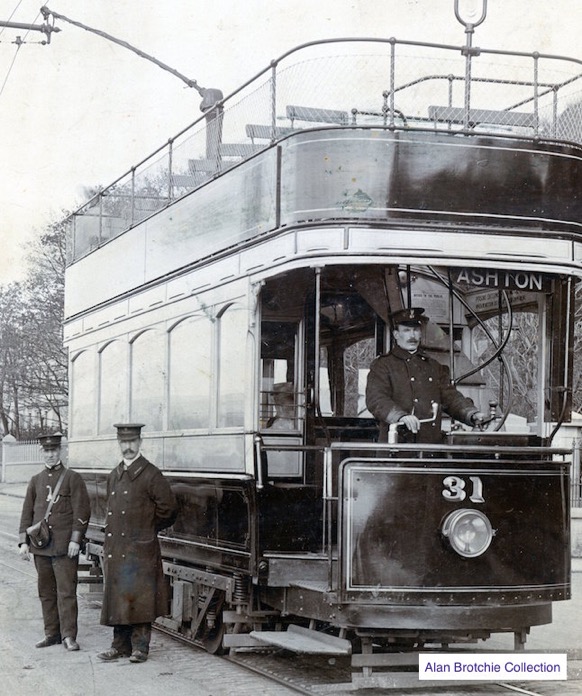
A conductor, an inspector and a motorman with newly rebuilt Tramcar No 31 at the Ashton terminus in 1906.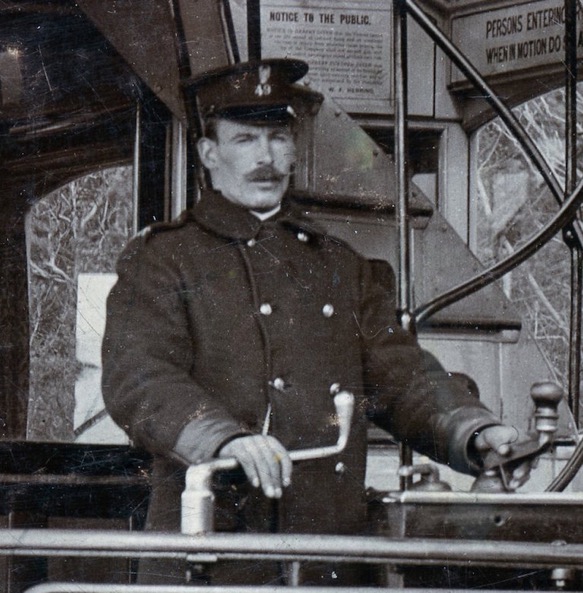
An enlargement of the above photograph showing the motorman (Employee No 49). His cap bears the standard issue British Electric Traction Company 'Magnet & Wheel' cap badge and his employee number.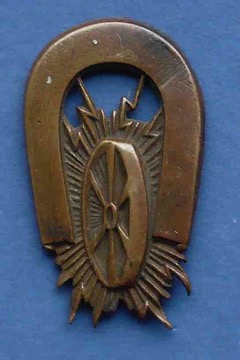
British Electric Traction Company ‘Magnet & Wheel’ cap badge, as issued to staff working the G&PGTCo's electric services, from 1901 onwards — brass. Author's Collection.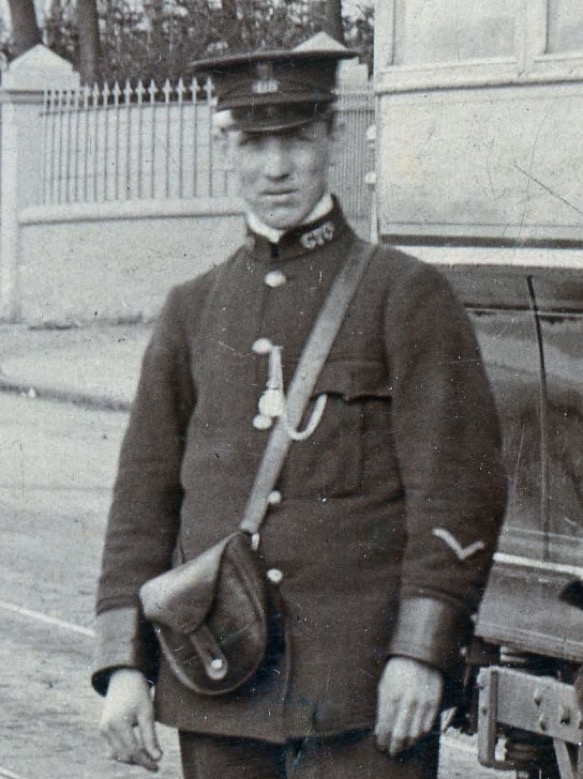
Another blow-up of the shot of Tramcar No 31 above, this time showing the conductor, possibly Employee Number 65. His collar insignia are the company initials, with 'GTCo' clearly visible on his left-hand collar. The precise purpose of the chevron on his sleeve is unclear, though it probably denoted good conduct or long service.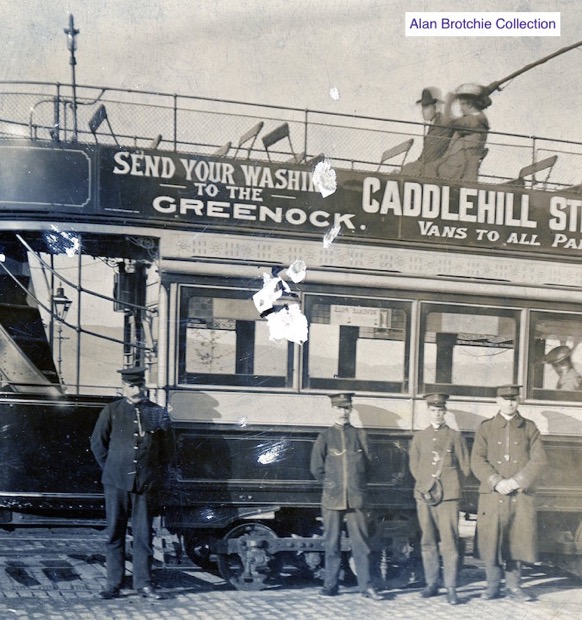
An unidentified tram at what is probably Ashton, together with its crew, an inspector and another tramway employee — photo undated, but probably late Edwardian.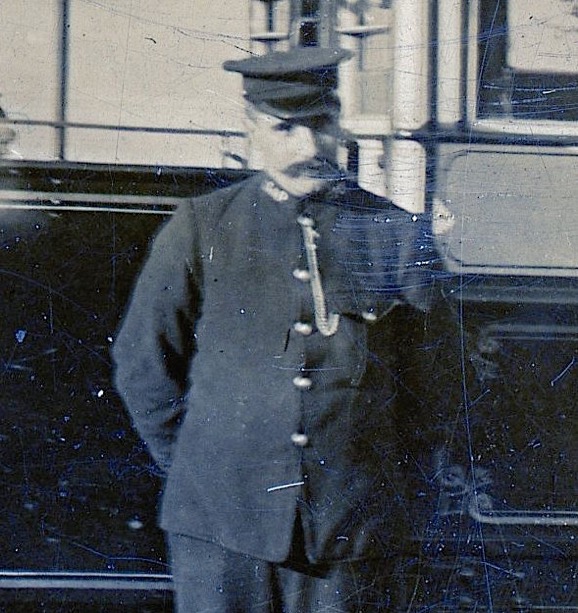
An enlargement of the above photograph showing the figure on the left (presumably either a motorman or a conductor). Although blurred (the camera has moved), the subject's right-hand collar initials — 'G&P' — are easily discerned.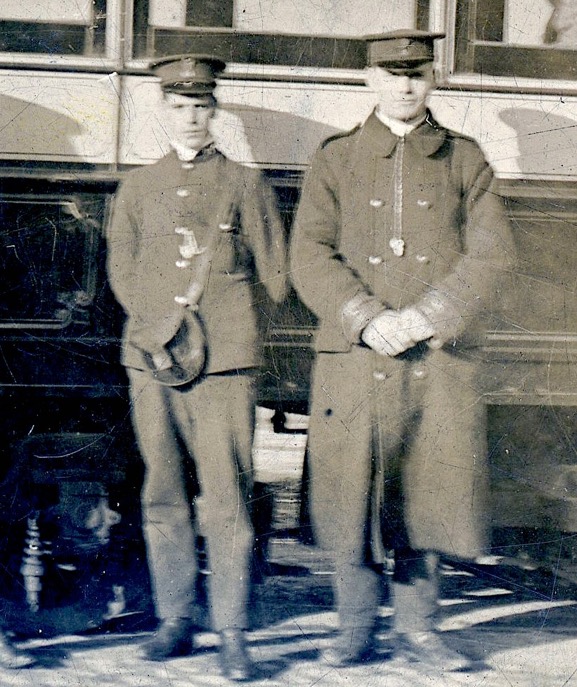
Another blow-up of the above photograph, this time showing the two figures on the right, very probably the conductor and the motorman.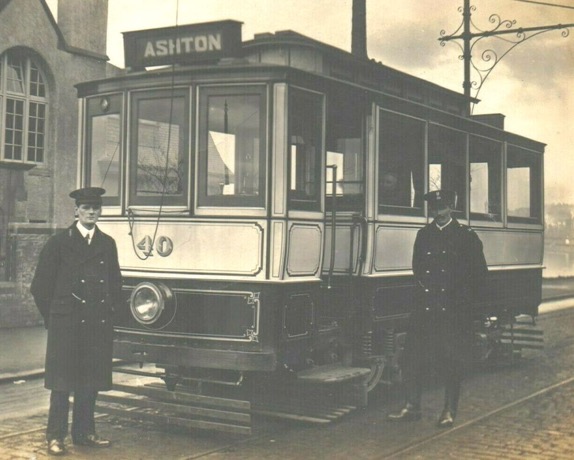
Tramcar No 40 with an inspector and a motorman at the Ashton terminus — photo undated, but judging by the condition of the vehicle, probably taken in 1908. With thanks to Alan Brotchie.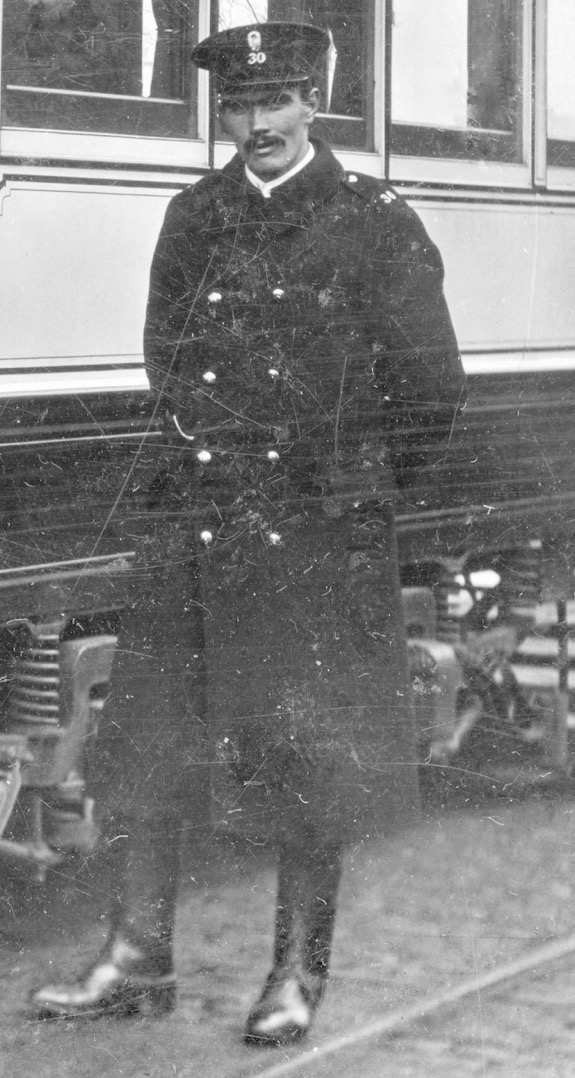
An enlargement of the above photograph showing the motorman; his greatcoat epaulettes carry his employee number, '30'.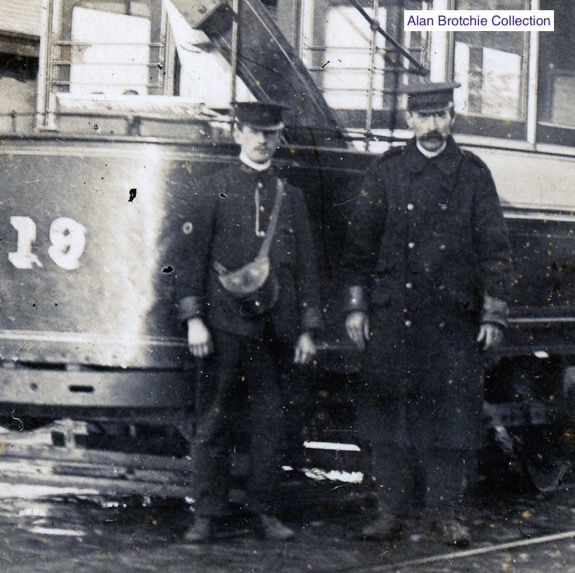
The crew of Tramcar No 19 stand with their charge at Ashton — photo undated, but possibly taken just prior to the Great War.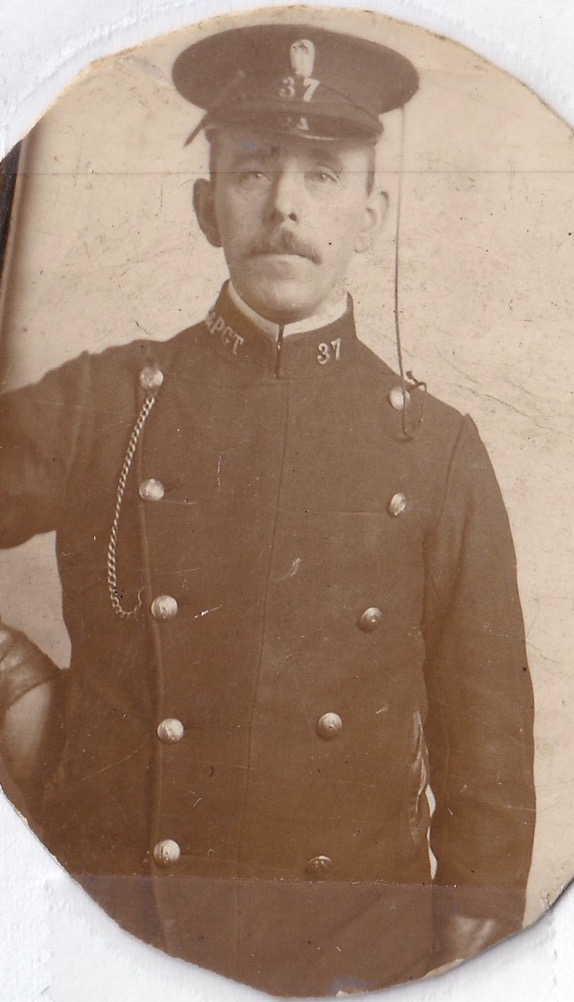
A rare studio portrait of a Greenock and Port Glasgow Tramways Company employee (No 37), James Sheridan, who is recorded as a conductor in 1909, though he may have been a motorman when this photograph was taken, which was possibly between 1909 and the Great War. Mr Sheridan was born in Navan, County Meath in 1875, and came to the Glasgow area some time between 1904 and 1909. He is wearing a lancer-style tunic, the collars of which, unlike the earlier jackets, bear the system initials on one side rather than company initials across both collars. His cap appears to be tethered to one of the buttons on his tunic, suggesting that it may have been quite a windy route! Photograph courtesy of Daniel Gallagher.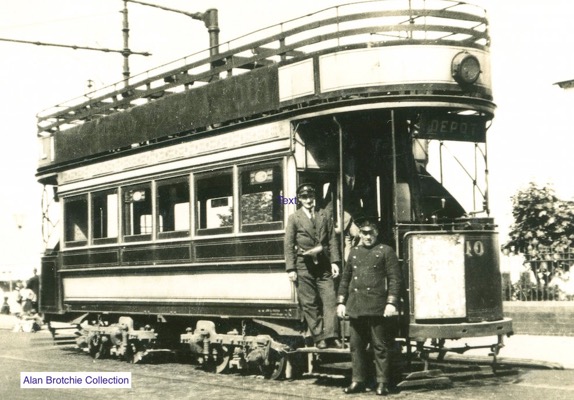
A conductor and a motorman with Tramcar No 10 at Ashton in 1929.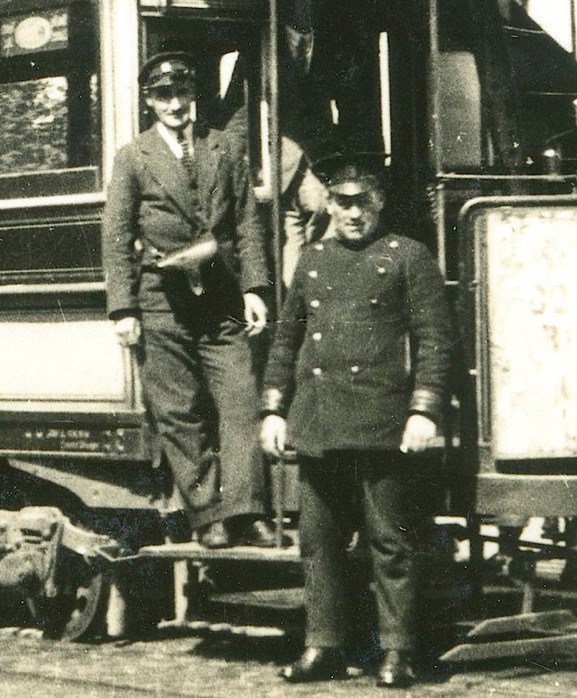
An enlargement of the above photograph showing the conductor (wearing informal attire) and the motorman (in lancer-style tunic, which is a missing button). The conductor's cap is almost railway-like in appearance, presumably having had the tensioning wire removed. It carries a non-standard cap badge, which almost certainly had nothing to do with the tramway.
Senior staff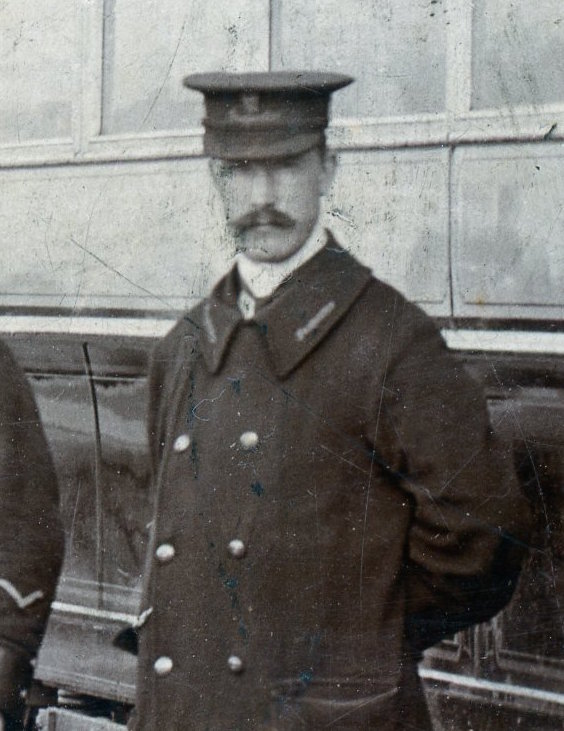
A G&PGTCo inspector — taken from the 1906 photograph above. His greatcoat collars and hat band bear his grade — 'Inspector' — in embroidered script lettering, whilst his cap also has the standard BETCo 'Magnet & Wheel' cap badge.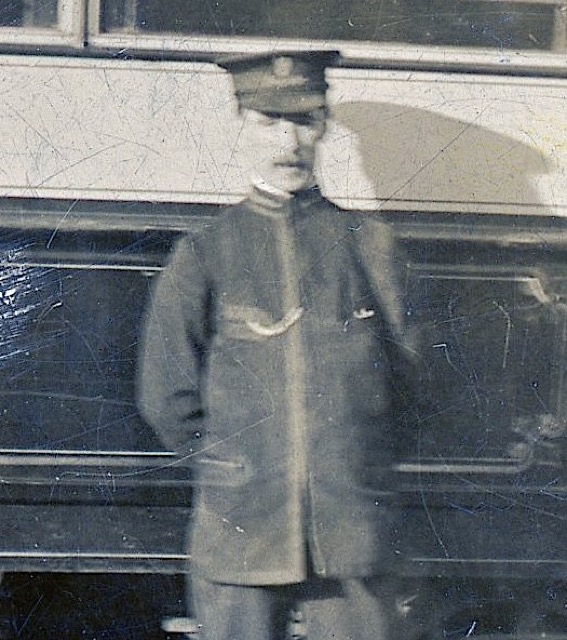
A G&PGTCo inspector taken from the late-Edwardian photograph above. He is wearing a typical tramway inspector's tunic with hidden buttons (or more likely a hook and eye arrangement), with embroidered grade insignia on both the collars and the cap. It is entirely possible that he is the same individual depicted in the previous photograph.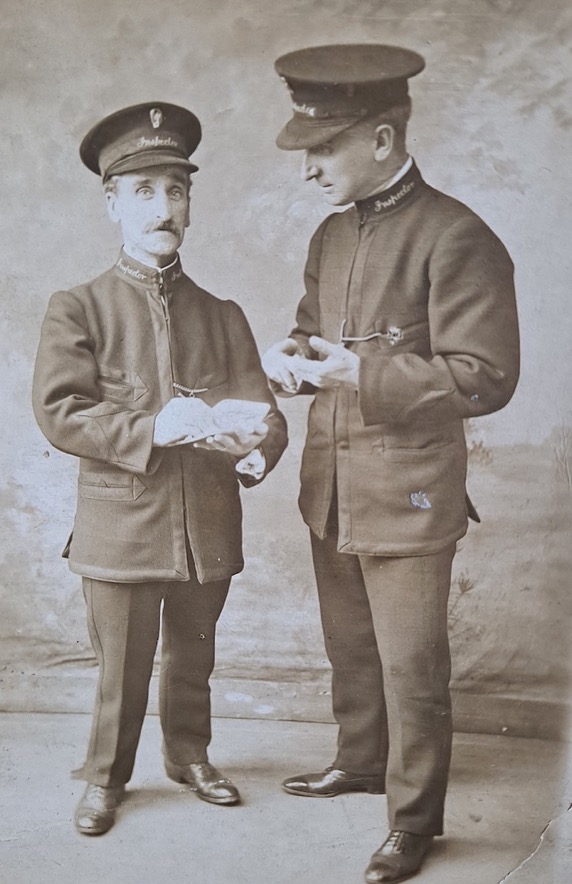
A studio portrait of two G&PGTCo inspectors, who are in a highly unusual interactive pose rather than the formal portrait style much favoured by Victorian and Edwardian photographers — photo undated, but probably taken in the mid-to-late Edwardian era. Photo courtesy of Christine Allan (nee Branscombe).
Female staff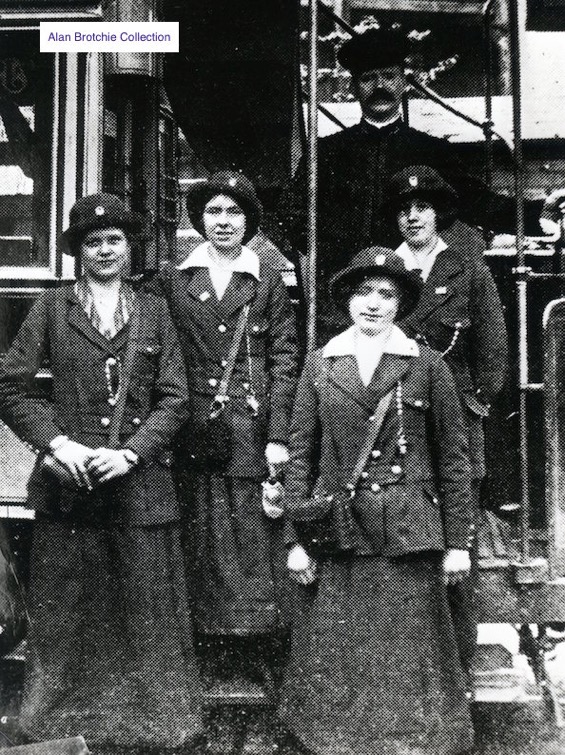
The G&PGTCo's first Great War conductresses in their tailored uniforms and felt bonnets (with standard BETCo cap badge). The lady on the left, who became the first motorwoman on the system, is called Matilda Morgan.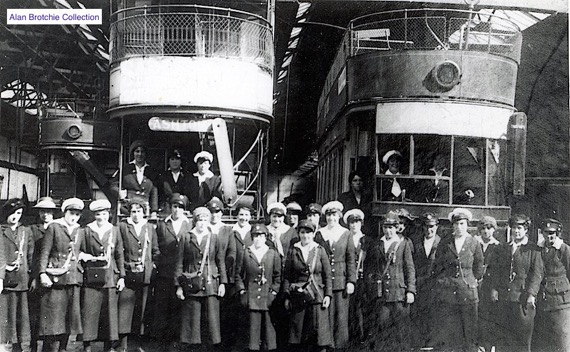
A depot shot featuring what was probably the entire female staff (conductresses and motorwomen) of the G&PGTCo — photo probably taken in 1918.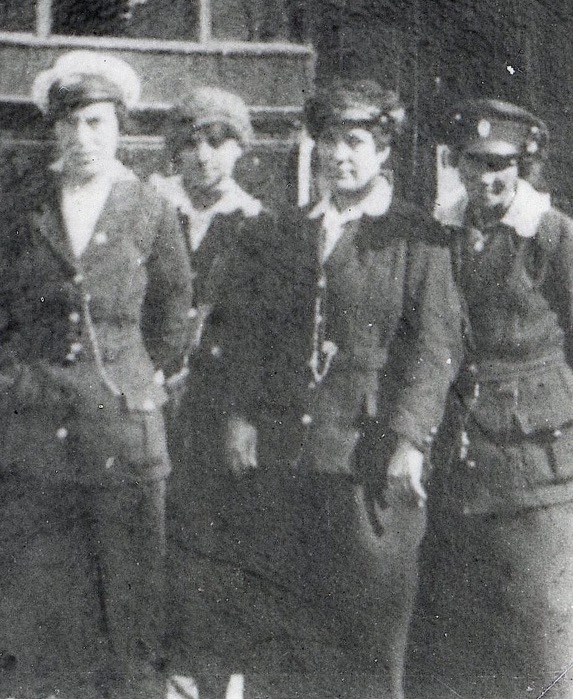
An enlargement of the above photograph showing four of the ladies in their baggy peaked motor caps.